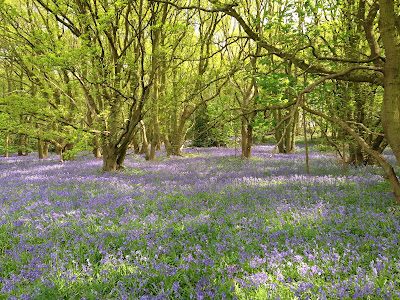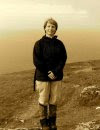I made a wild run across London from Kew, where I was giving a lecture and tour, to Highgate for the special access tour to the west cemetery. Using overground trains, underground trains, underground tunnels, and overground paths, it took an hour and twenty minutes to cross The City. The tours of the West Cemetery were booked solid, and this was the first available when I booked it a month ago. The planning, the running, the train platform hunting, the navigation of the housing complex interior paths up Swain's Lane, all were worth it for such an immersion in the Victorian Cult of Death.
Here is the "Heaven's Gate" through which one enters Highgate West. This area is restricted because of the fragile nature of the tombs and the managed jungle of the environment. They opened it to the public in the 1970's, but the vandalism was rampant (!?), so it became closed to the public except for special tours, on which the guides are vigilant for bad behavior of the participants.
Highgate was begun in 1839 to address the problem of not enough grave space in London as the population doubled. The funerary sculpture is exquisite, and the cultural practices are fascinating.
There were angels, escorting the dead to heaven:

And angels sleeping with the dead:
Really, the jungle growing up around it adds to the mysteriousness of the location. Inside the Egyptian Tombs are inhabitants in coffins in the hallway up to the central area.
Inside there are more crypts in a circle with an enormous Cedar of Lebannon on top of it. The doors are decorated with upside down torches that show the inhabitants no longer have need of light. There are also tombs along the curving interior section with increasing overgrowth adding to the feeling of genteel decay and riotous nature.
Here is the "Heaven's Gate" through which one enters Highgate West. This area is restricted because of the fragile nature of the tombs and the managed jungle of the environment. They opened it to the public in the 1970's, but the vandalism was rampant (!?), so it became closed to the public except for special tours, on which the guides are vigilant for bad behavior of the participants.
Highgate was begun in 1839 to address the problem of not enough grave space in London as the population doubled. The funerary sculpture is exquisite, and the cultural practices are fascinating.
There were angels, escorting the dead to heaven:

And angels sleeping with the dead:
The entire place feels excessive, but the crowning glory in the Egyptian Tombs. Here is the opulent entrance. Evidently it was quite brightly painted 180 years ago, but now it is a somber grey.
Inside there are more crypts in a circle with an enormous Cedar of Lebannon on top of it. The doors are decorated with upside down torches that show the inhabitants no longer have need of light. There are also tombs along the curving interior section with increasing overgrowth adding to the feeling of genteel decay and riotous nature.
The light on this day was cloudy but bright, which makes the photos almost naturally sepia toned. While walking through the cemetery, the guide told us much about the people coming for picnics with the dead in Victorian times, and how people still come with a bottle of wine to sit and chat with the dearly departed.
There are still quite well known people interred in the cemetery. For example, the famous bare knuckle fighter, Thomas Sayers, is interred here with a memorial to his beloved dog, Lion. The anecdote is that the first carriage in the cortege contained the mortal remains of Mr. Sayers, the second carriage had Lion in it, dressed in a black crepe ruff, and in the third carriage came Mrs. Sayers.
Other famous resting places include Mr. Karl Marx, upon whose tomb two candles burned, and Mr. Douglas Adams, upon whose grave is a pencil cup where people pay their respects by leaving a pen or pencil.
Both East and West Highgate are sublime in the technical sense of being beyond the scope of normal rational perception. the light was dispersed so the green was vivid and the grey glowed. There are graves upon graves and tombstones and monuments tumbled together as far the eye can see into the thick woods. There are angels, crosses, plinths, gothic arches, more angels, more celtic crosses, all jammed in together. Many are covered with ivy, some are tumbled down. Some tombstones have skewed off their boxes and the holes in the earth gape black. There are so many names! and so many lost names.
Most of the graves seem to be forgotten, but some are well tended. There are little paths that wind through the jungle-like woods. It would seem that there are also "quiet graves". These are plots that are not spoken of since the person memorialized does not want tourist visitors or pilgrims. Douglas Adams clearly does not mind: he is right in front in the East Cemetery.
I highly recommend a visit to the East Cemetery, which is always open to the public. It is worth the special tour of the West Cemetery, but go to the Highgate Website and reserve a place well before your visit. Plan at least three or four hours to really grok the place. Bring a picnic.



























